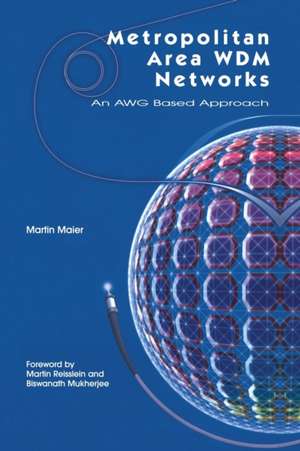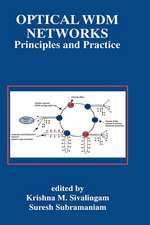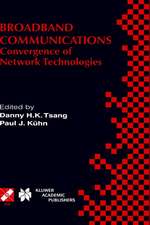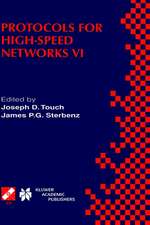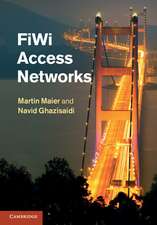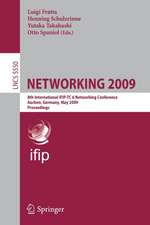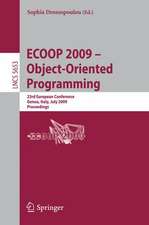Metropolitan Area WDM Networks: An AWG Based Approach
Autor Martin Maieren Limba Engleză Paperback – 30 oct 2012
| Toate formatele și edițiile | Preț | Express |
|---|---|---|
| Paperback (1) | 989.79 lei 6-8 săpt. | |
| Springer Us – 30 oct 2012 | 989.79 lei 6-8 săpt. | |
| Hardback (1) | 1000.18 lei 6-8 săpt. | |
| Springer Us – 29 sep 2003 | 1000.18 lei 6-8 săpt. |
Preț: 989.79 lei
Preț vechi: 1237.24 lei
-20% Nou
Puncte Express: 1485
Preț estimativ în valută:
189.42€ • 195.68$ • 157.65£
189.42€ • 195.68$ • 157.65£
Carte tipărită la comandă
Livrare economică 25 martie-08 aprilie
Preluare comenzi: 021 569.72.76
Specificații
ISBN-13: 9781461351139
ISBN-10: 1461351138
Pagini: 352
Ilustrații: XXXV, 312 p.
Dimensiuni: 155 x 235 x 18 mm
Greutate: 0.49 kg
Ediția:2004
Editura: Springer Us
Colecția Springer
Locul publicării:New York, NY, United States
ISBN-10: 1461351138
Pagini: 352
Ilustrații: XXXV, 312 p.
Dimensiuni: 155 x 235 x 18 mm
Greutate: 0.49 kg
Ediția:2004
Editura: Springer Us
Colecția Springer
Locul publicării:New York, NY, United States
Public țintă
ResearchDescriere
Metropolitan Area WDM Networks: An AWG Based Approach provides a comprehensive and technically detailed overview of the latest metropolitan area WDM network experimental systems, architectures, and access protocols. Its main focus is on the novel star WDM networks based on a wavelength-selective Arrayed-Waveguide Grating (AWG). Network researchers, engineers, professionals, and graduate students will benefit from the thorough overview and gain an in-depth understanding of current and next-generation metro WDM networks.
The AWG based metro star WDM network is discussed at length and extensively investigated by means of stochastic analyses and simulations. The book provides:
*an up-to-date overview of ring and star metro WDM networks and access protocols,
*in-depth performance comparison studies of AWG based multihop vs. single-hop WDM networks and AWG vs. Passive Star Coupler based single-hop WDM networks,
*a thorough description of the AWG based network and node architectures and access protocols,
*a novel highly-efficient approach to provide survivability for star WDM networks,
*extensive analytical results for both unicast and multicast variable-size packet traffic and bandwidth on demand,
*supplementary simulation results, including packet header trace files.
The AWG based metro star WDM network is discussed at length and extensively investigated by means of stochastic analyses and simulations. The book provides:
*an up-to-date overview of ring and star metro WDM networks and access protocols,
*in-depth performance comparison studies of AWG based multihop vs. single-hop WDM networks and AWG vs. Passive Star Coupler based single-hop WDM networks,
*a thorough description of the AWG based network and node architectures and access protocols,
*a novel highly-efficient approach to provide survivability for star WDM networks,
*extensive analytical results for both unicast and multicast variable-size packet traffic and bandwidth on demand,
*supplementary simulation results, including packet header trace files.
Cuprins
I Introduction.- 1. Basics.- 1.1 Components.- 1.1.1 Combiners and splitters.- 1.1.2 Passive star coupler (PSC).- 1.1.3 Arrayed-waveguide grating (AWG).- 1.1.4 Transmitters and receivers.- 1.2 Transmission impairments.- 1.2.1 Attenuation.- 1.2.2 Dispersion.- 1.2.3 Nonlinearities.- 1.2.4 Crosstalk.- 1.2.5 Noise.- II Metro WDM Networks.- 2. Ring Networks.- 2.1 Experimental systems.- 2.1.1 KomNet.- 2.1.2 RINGO.- 2.1.3 HORNET.- 2.2 WDM rings and access protocols.- 2.2.1 Slotted rings without channel inspection.- 2.2.2 Slotted rings with channel inspection.- 2.2.3 Slotted rings with control channel.- 2.2.4 Multitoken rings.- 2.2.5 Meshed rings.- 2.3 Fairness control and QoS support.- 2.3.1 Fairness control.- 2.3.2 QoS support.- 3. Star Networks.- 3.1 Experimental systems.- 3.1.1 RAINBOW.- 3.1.2 Telstra.- 3.1.3 NTT.- 3.2 Single-hop WDM networks and access protocols.- 3.2.1 Preallocation protocols.- 3.2.2 Random access protocols.- 3.2.3 Reservation protocols.- 3.2.4 Hybrid protocols.- 3.2.5 Resulting guidelines.- III AWG Based Approach.- 4. Architectural Comparisons.- 4.1 Single-hop vs. multihop AWG based networks.- 4.1.1 Architecture.- 4.1.2 Mean hop distance.- 4.1.3 Capacity.- 4.1.4 Results.- 4.1.5 Discussion.- 4.2 PSC vs. AWG based single-hop networks.- 4.2.1 Spatial wavelength reuse.- 4.2.2 Architecture and wavelength assignment.- 4.2.3 Analysis.- 4.2.4 Results.- 4.2.5 Discussion.- 4.3 Conclusions.- 5. Architecture and Protocol.- 5.1 Network requirements.- 5.2 Architecture.- 5.2.1 Underlying principles.- 5.2.2 Network and node architecture.- 5.3 MAC protocol.- 5.3.1 Protocol.- 5.3.2 An illustrative example.- 5.3.3 Discussion.- 5.4 Conclusions.- 6. Performance Evaluation.- 6.1 Using multiple FSRs.- 6.1.1 Assumptions.- 6.1.2 Model.- 6.1.3 Analysis.- 6.1.4 Results.- 6.2 Spatial wavelength reuse.- 6.2.1 Assumptions.- 6.2.2 Analysis.- 6.2.3 Results.- 6.3 Multicasting.- 6.3.1 Multicasting with partitioning.- 6.3.2 Multicasting simultaneously with control.- 6.4 Supplementary simulation results.- 6.4.1 Self-stability.- 6.4.2 Packet loss.- 6.4.3 Circuit switching.- 6.4.4 Benchmark comparison.- 6.5 Conclusions.- 7. Network Dimensioning and Reconfiguration.- 7.1 Multiservice convergence.- 7.2 Multiobjective optimization.- 7.2.1 Objective functions.- 7.2.2 Decision variables and constraints.- 7.2.3 Pareto optimality.- 7.3 Genetic algorithms.- 7.3.1 Basic principle.- 7.3.2 Genetic operations.- 7.4 Results.- 7.4.1 Pareto-optimal architecture planning.- 7.4.2 Pareto-optimal network operation.- 7.5 Conclusions.- 8. Feasibility Issues.- 8.1 Transmission limitations.- 8.1.1 Eye diagrams.- 8.1.2 Q factor.- 8.2 Packet traces.- 8.3 Discussion.- 8.4 Conclusions.- 9. Protection.- 9.1 Heterogeneous protection.- 9.2 AWG PSC architecture.- 9.3 MAC protocols.- 9.3.1 AWG-PSCmode.- 9.3.2 PSC-only mode.- 9.3.3 AWG-only mode.- 9.4 Results.- 9.5 Conclusions.- 10. Conclusions.- 10.1 Future research avenues.- 10.2 Standardization activities.- IV Appendices.- Appendices.- A Acronyms.- B.1 Refined approximation.- B.2 Numerical evaluation.- References.
Recenzii
"We believe that this book will be an important contribution in this exciting development in optical networking."
From the Foreword by Dr. Martin Reisslein, Arizona State University and Dr. Biswanath Mukherjee, University of California, Davis
From the Foreword by Dr. Martin Reisslein, Arizona State University and Dr. Biswanath Mukherjee, University of California, Davis
